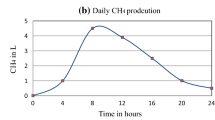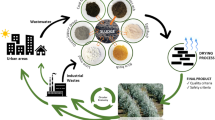Abstract
To characterize the drying of dairy manure during microwave (MW) heating, and to determine the impacts of microwave radiation on reductions of antibiotic resistance genes (ARGs), this study investigated on understanding the effects of microwave heating on solid streams of flushed dairy manure. A series of experiments were performed to determine the rate of drying, moisture removal percentages, change in solids, and the level of ARGs. Manure was exposed to microwave radiation for 30–300 s at a frequency of 2450 MHz. The results showed moisture removal rate (U) up to 0.63-g water per minute per gram of dairy manure. During MW treatment, volatile solid (VS) content was relatively stable. The MW treatment resulted in reduction of ARGs such as sulII, intI1, and tnpA. The ARG concentrations (sulII, intI1, and tnpA) were reduced by 2 orders of magnitude in less than 1 min of microwave heating. The preliminary results of this study showed that MW treatment can be a viable option for drying of dairy manure and reducing ARGs in manure.



Similar content being viewed by others
Data availability
All data and supporting materials of this study are included in the manuscript.
References
Alcaraz JM, Baticados EJ, Capareda SG, Maglinao AS, Nam H (2018) Drying and pellet characterization of sand-separated dairy manure from Stephenville, Texas, USA. Appl. Ecol. Environ. Res 16(1):29–38
Aminov R, Garrigues-Jeanjean N, Mackie R (2001) Molecular ecology of tetracycline resistance: development and validation of primers for detection of tetracycline resistance genes encoding ribosomal protection proteins. Appl Environ Microbiol 67(1):22–32
APHA (2005) Standard methods for the examination of water and wastewater (American Water Works Association and Water Environment Federation), 21st edn. American Public Health Association, Washington, D.C.
Arpia AA, Chen WH, Lam SS, Rousset P, Luna MDGD (2020) Sustainable biofuel and bioenergy production from biomass waste residues using microwave-assisted heating: A comprehensive review. Chem Eng J:403. https://doi.org/10.1016/j.cej.2020.126233
Benali M, Kudra T (2002) Thermal dewatering of diluted organic suspensions: process mechanism and drying kinetics. Dry Technol 20(4-5):935–951
Bird RB (2002) Transport phenomena. Appl Mech Rev 55(1):R1–R4
Cai Y, He Y, He K, Gao H, Ren M, Qu G (2019) Degradation mechanism of lignocellulose in dairy cattle manure with the addition of calcium oxide and superphosphate. Environ Sci Pollut Res 26:33683–33693
Chang J, Jiang T, Zhao M, Yang J, Wen Z, Yang F, Ma X, Li G (2020) Variation pattern of antibiotic resistance genes and microbial community succession during swine manure composting under different aeration strategies. J Chem Technol Biotechnol 95:466–473
Costa A, Gusmara C, Gardoni D, Zaninelli M, Tambone F, Sala V, Guarino M (2017) The effect of anaerobic digestion and storage on indicator microorganisms in swine and dairy manure. Environ Sci Pollut Res 24:24135–24146
Gao Y, Liu Y, Zhu G, Xu J, Yuan Q, Zhu Y, Sarma J, Wang Y, Wang J, Ji L (2018) Microwave-assisted hydrothermal carbonization of dairy manure: chemical and structural properties of the products. Energy 165:662–672
Garcimartin M, Ovejero I, Sanchez E, Sanchez-Giron V (2007) Application of the sensible heat balance to determine the temperature tolerance of commercial poultry housing. World's Poultry Sci J 63(4):575–584
Ghaly A, MacDonald K (2012a) An effective passive solar dryer for thin layer drying of poultry manure. Am J Eng Appl Sci 5(3):136–150
Ghaly A, MacDonald K (2012b) Drying of poultry manure for use as animal feed. Am J Agric Biol Sci 7(2):239–254
Hanifzadeh M, Nabati Z, Longka P, Malakul P, Apul D, Kim D-S (2017) Life cycle assessment of superheated steam drying technology as a novel cow manure management method. J Environ Manag 199:83–90
Hardwick SA, Stokes H, Findlay S, Taylor M, Gillings MR (2008) Quantification of class 1 integron abundance in natural environments using real-time quantitative PCR. FEMS Microbiol Lett 278(2):207–212
Hjorth M, Christensen KV, Christensen ML, Sommer SG (2011) Solid–liquid separation of animal slurry in theory and practice. Sustainable agriculture volume 2. Springer, pp 953–986
Hou Y, Velthof G, Case S, Oelofse M, Grignani C, Balsari P, Zavattaro L, Gioelli F, Bernal M, Fangueiro D (2018) Stakeholder perceptions of manure treatment technologies in Denmark, Italy, the Netherlands and Spain. J Clean Prod 172:1620–1630
Hu E, Sutitarnnontr P, Tuller M, Jones SB (2018) Modeling temperature and moisture dependent emissions of carbon dioxide and methane from drying dairy cow manure. Agric Sci Eng 5(2):280–286
Khalil TM, Higgins SS, Ndegwa PM, Frear CS, Stöckle CO (2016) Assessing the effect of different treatments on decomposition rate of dairy manure. J Environ Manag 182:230–237
Kim SY, Jo EK, Kim HJ, Bai K, Park JK (2008) The effects of high-power microwaves on the ultrastructure of Bacillus subtilis. Lett Appl Microbiol 47(1):35–40
Lu X-M, Lu P-Z (2019) Synergistic effects of key parameters on the fate of antibiotic resistance genes during swine manure composting. Environ Pollut 252:1277–1287
Ma Y, Wilson CA, Novak JT, Riffat R, Aynur S, Murthy S, Pruden A (2011) Effect of various sludge digestion conditions on sulfonamide, macrolide, and tetracycline resistance genes and class I integrons. Environ Sci Technol 45:7855–7861
Mawioo PM, Rweyemamu A, Garcia HA, Hooijmans CM, Brdjanovic D (2016) Evaluation of a microwave based reactor for the treatment of blackwater sludge. Sci Total Environ 548:72–81
Mawioo PM, Garcia HA, Hooijmans CM, Velkushanova K, Simonič M, Mijatović I, Brdjanovic D (2017) A pilot-scale microwave technology for sludge sanitization and drying. Sci Total Environ 601:1437–1448
Moller H, Hansen JD, Sorensen C (2007) Nutrient recovery by solid-liquid separation and methane productivity of solids. Trans ASABE 50(1):193–200
Muyzer G, De Waal EC, Uitterlinden AG (1993) Profiling of complex microbial populations by denaturing gradient gel electrophoresis analysis of polymerase chain reaction-amplified genes coding for 16S rRNA. Appl Environ Microbiol 59(3):695–700
Orikasa T, Koide S, Sugawara H, Yoshida M, Kato K, Matsushima U, Okada M, Watanabe T, Ando Y, Shiina T (2018) Applicability of vacuum-microwave drying for tomato fruit based on evaluations of energy cost, color, functional components, and sensory qualities. J Food Process Preserv 42(6):e13625
Pandey P, Ndegwa P, Soupir M, Alldredge R, Pitts M (2011) Efficacies of inocula on the startup of anaerobic reactors treating dairy manure under stirred and unstirred conditions. Biomass Bioenergy 35:2705–2720
Pandey PK, Cao W, Biswas S, Vaddella V (2016) A new closed loop heating system for composting of green and food wastes. J Clean Prod 133:1252–1259
Pandey P, Chiu C, Miao M, Wang Y, Settles M, del Rio NS, Castillo A, Souza A, Pereira R, Jeannotte R (2018) 16S rRNA analysis of diversity of manure microbial community in dairy farm environment. PLoS One 13:e0190126. https://doi.org/10.1371/journal.pone.0190126
Pei R, Kim S-C, Carlson KH, Pruden A (2006) Effect of river landscape on the sediment concentrations of antibiotics and corresponding antibiotic resistance genes (ARG). Water Res 40(12):2427–2435
Prapaspongsa T, Poulsen T, Hansen JA, Christensen P (2010) Energy production, nutrient recovery and greenhouse gas emission potentials from integrated pig manure management systems. Waste Manag Res 28(5):411–422
Pu C, Liu H, Ding G, Sun Y, Yu X, Chen J, Ren J, Gong X (2018) Impact of direct application of biogas slurry and residue in fields: in situ analysis of antibiotic resistance genes from pig manure to fields. J Hazard Mater 344:441–449
Qian X, Gu J, Sun W, Wang X-J, Su J-Q, Stedfeld R (2018) Diversity, abundance, and persistence of antibiotic resistance genes in various types of animal manure following industrial composting. J Hazard Mater 344:716–722
Qian X, Shen G, Wang Z, Chen X, Zhao Q, Bai Y, Tang Z (2020) Application of dairy manure as fertilizer in dry land in East China: field monitoring and model estimation of heavy metal accumulation in surface soil. Environ Sci Pollut Res. https://doi.org/10.1007/s11356-020-09786-x
Srinivasan A, Liao PH, Lo KV (2016) Microwave treatment of dairy manure for resource recovery: reaction kinetics and energy analysis. J Environ Sci Health B 51(12):840–846
Sun W, Qian X, Gu J, Wang X-J, Duan M-L (2016) Mechanism and effect of temperature on variations in antibiotic resistance genes during anaerobic digestion of dairy manure. Sci Rep 6:1–9
Tian Z, Chi Y, Yu B, Yang M, Zhang Y (2019) Thermophilic anaerobic digestion reduces ARGs in excess sludge even under high oxytetracycline concentrations. Chemosphere 222:305–313
Tichenor NE, Peters CJ, Norris GA, Thoma G, Griffin TS (2017) Life cycle environmental consequences of grass-fed and dairy beef production systems in the Northeastern United States. J Clean Prod 142:1619–1628
Tien Y-C, Li B, Zhang T, Scott A, Murray R, Sabourin L, Marti R, Topp E (2017) Impact of dairy manure pre-application treatment on manure composition, soil dynamics of antibiotic resistance genes, and abundance of antibiotic-resistance genes on vegetables at harvest. Sci Total Environ 581:32–39
USDA-NASS (2020) Cattle inventory–agriculture count. https://www.nass.usda.gov/Charts_and_Maps/Cattle/index.php (accessed on 8/13/2020).
Venkatesh M, Raghavan G (2004) An overview of microwave processing and dielectric properties of agri-food materials. Biosyst Eng 88(1):1–18
Wichmann F, Udikovic-Kolic N, Andrew S, Handelsman J (2014) Diverse antibiotic resistance genes in dairy cow manure. MBio 5(2):e01017–e01013
Xie S, Wu N, Tian J, Liu X, Wu S, Mo Q, Lu S (2019) Review on the removal of antibiotic resistance genes from livestock manure by composting, IOP Conference Series: Earth and Environmental. Science. 237:052010
Zambra C, Moraga N, Escudey M (2011) Heat and mass transfer in unsaturated porous media: moisture effects in compost piles self-heating. Int J Heat Mass Transf 54(13-14):2801–2810
Zhu Y-G, Johnson TA, Su J-Q, Qiao M, Guo G-X, Stedtfeld RD, Hashsham SA, Tiedje JM (2013) Diverse and abundant antibiotic resistance genes in Chinese swine farms. Proc Natl Acad Sci 110(9):3435–3440
Acknowledgments
The author thank Doug Gisi, the manager of UC Davis Dairy Teaching and Research Facility, and his staff for manure collection. The authors appreciate the valuable feedback and suggestions by Dr. Sundaram Kuppu during the revision of the manuscript.
Funding
The authors thank the California Department of food and Agriculture (CDFA)’s Alternative Manure Management Program (AMMP) for providing support for manure research. The authors also gratefully acknowledge the support from the International Clean Energy Talent Program of China Scholarship Council (No. 201902720026) and the Agricultural Science and Technology Innovation Program (ASTIP) of the Chinese Academy of Agricultural Sciences.
Author information
Authors and Affiliations
Contributions
TL and PP were involved in method and experiment development. TL performed the experiments with assistance from PP. TL and YW worked on sample analysis. TL wrote the first draft with YW’s assistance. PP helped TL and YW in writing and revision of the manuscript. All authors read and approved the final manuscript.
Corresponding author
Ethics declarations
Competing interests
The authors declare that they have no competing interests.
Ethics approval
This article does not contain any studies with either human participants or animals. Ethical approval is not required.
Consent to participate
Consent to participate is not required.
Consent for publication
All authors gave their consent for publication.
Additional information
Responsible editor: Diane Purchase
Publisher’s note
Springer Nature remains neutral with regard to jurisdictional claims in published maps and institutional affiliations.
Rights and permissions
About this article
Cite this article
Luo, T., Wang, Y. & Pandey, P. The removal of moisture and antibiotic resistance genes in dairy manure by microwave treatment. Environ Sci Pollut Res 28, 6675–6683 (2021). https://doi.org/10.1007/s11356-020-10986-8
Received:
Accepted:
Published:
Issue Date:
DOI: https://doi.org/10.1007/s11356-020-10986-8




